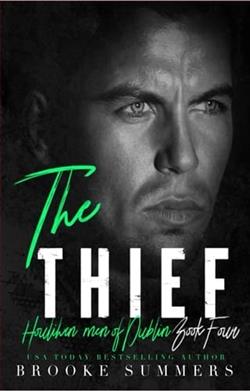Page 94 of Troubled Blood
After glancing up again to check that SB hadn’t yet emerged, Strike read on:
where he runs events for the campers by day and performs in the cabaret by night. His “Longfellow Serenade” is a particular hit with the ladies. Dark-haired Douthwaite/Jacks remains a handsome man, and clearly popular with female campers.
“I’ve always liked singing,” he tells me in the bar after the show. “I was in a band when I was younger but it broke up. I came to Butlin’s once when I was a kid, with my foster family. I always thought it looked a laugh, being a Redcoat. Plenty of big-time entertainers got their start here, you know.”
When talk turns to Margot Bamborough, however, a very different side to this cheeky cabaret singer appears.
“The press wrote a load of balls. I never bought her chocolates or anything else, that was just made up to make me look like some kind of creep. I had a stomach ulcer and headaches. I’d been through a bad time.”
After refusing to explain why he’d changed his name, Douthwaite left the bar.
His colleagues at the holiday camp expressed their shock that “Stevie” had been questioned by the police over the disappearance of the young doctor.
“He never told us anything about it,” said Julie Wilkes, 22. “I’m quite shocked, actually. You’d think he’d have told us. He never said ‘Jacks’ wasn’t his real name, either.”
Oakden treated his readers to a brief history of Butlin’s, and ended the chapter with a paragraph of speculation on the opportunities a predatory man might find at a holiday camp.
Strike lit another cigarette, then flicked ahead to the second of Robin’s markers, where a short passage dealt with Jules Bayliss, husband of the office-cleaner-turned-social-worker, Wilma. The only piece of new information here was that convicted rapist Bayliss had been released on bail in January 1975, a full three months after Margot went missing. Nevertheless, Oakden asserted that Bayliss “would have got wind” of the fact that Margot was trying to persuade his wife to leave him, “would have been angry that the doctor was pressurizing his wife to break up the family” and “would have had many criminal associations in his own community.” The police, Oakden informed his readers, “would have looked carefully into the movements of any of Bayliss’s friends or relatives on the eleventh of October, so we must conclude,” he finished, anticlimactically, “that no suspicious activity was uncovered.”
Robin’s third tab marked the pages dealing with the abortion at Bride Street Nursing Home. Oakden ushered in this part of his story with considerable fanfare, informing his readers that he was about to reveal facts that had never before been made public.
What followed was interesting to Strike only in as far as it proved that an abortion had definitely taken place on the fourteenth of September 1974, and that the name given by the patient had been Margot Bamborough. As proof, Oakden reprinted photographs of the Bride Street medical records that had been provided by an unidentified employee of the nursing home, which had closed down in 1978. Strike supposed the unnamed employee would no longer have been fearful for their job when Oakden had come offering money for information in the eighties. The unnamed employee also told Oakden that the woman who had had the procedure didn’t resemble the picture of Margot that had subsequently appeared in the papers.
Oakden then posed a series of rhetorical questions that he and his foolhardy publishers appeared to think circumvented libel laws. Was it possible that the woman who had the abortion had used Margot’s name with her support and consent? In which case, who might Margot have been most eager to assist? Was it not most likely that a Roman Catholic would be particularly worried about anyone finding out she had had an abortion? Was it not also the case that complications could arise from such a procedure? Might Margot have returned to the vicinity of the Bride Street Nursing Home on the eleventh of October to visit somebody who had been readmitted to the clinic? Or to ask advice on behalf of that person? Could Margot possibly have been abducted, not from Clerkenwell, but from a street or two away from Dennis Creed’s basement?
To which Strike answered mentally, no, and you deserved to have your book pulped, pal. The string of events suggested by Oakden had clearly been put together in a determined attempt to place Margot in the vicinity of Creed’s basement on the night she disappeared. “Complications” were necessary to explain Margot returning to the nursing home a month after the abortion, but they couldn’t be Margot’s own, given that she was fit, well and working at the St. John’s practice all the way up to her disappearance. Once attributed to a best friend, however, undefined “complications” could serve two purposes: to give Margot a reason to head back to the clinic to visit Oonagh, and Oonagh a reason to lie about both women’s whereabouts that night. All in all, Strike considered Oakden lucky not to have been sued, and surmised that fear of the resultant publicity was all that had held Roy and Oonagh back.
He flicked forward to Robin’s fourth tab and, after checking again that the front door of the house he was watching remained closed, read the next marked passage.
“I saw her as clearly as I can see you now. She was standing at that window, pounding on it, as if she wanted to attract attention. I especially remember, because I was reading The Other Side of Midnight at the time and just thinking about women and what they go through, you know, and I looked up and I saw her.
“If I close my eyes, she’s there, it’s like a snapshot in my head and it’s haunted me ever since, to be honest. People have said to me since, ‘you’re making it up’ or ‘you need to let it go,’ but I’m not changing my story just because other people don’t believe it. What would that make me?”
The small printers who then occupied the top floor of the building was run by husband and wife team Arnold and Rachel Sawyer. Police accepted their assurance that Margot Bamborough had never set foot on the premises, and that the woman seen by Mandy that night was probably Mrs. Sawyer herself, who claimed one of the windows needed to be hit to close properly.
However, an odd connection between A&R Printing and Margot Bamborough went unnoticed by police. A&R’s first major printing job was for the now-closed nightclub Drudge—the very nightclub for which Paul Satchwell, Margot’s lover, had designed a risqué mural. Satchwell’s designs subsequently featured on flyers printed by A&R Printing, so it is likely that he and the Sawyers would have been in touch with each other.
Might this suggest…
“Fuck’s sake,” muttered Strike, turning the page and dropping his eyes to a brief paragraph Robin had marked with a thick black line.
However, ex-neighbor Wayne Truelove thinks that Paul Satchwell subsequently went abroad.
“He talked to me about going traveling. I don’t think he was making a lot of money from his art and after the police questioned him, he told me he was thinking of clearing out for a bit. Probably smart, going away.”
Robin’s fifth and final tab came toward the end of the book, and after again checking that SB’s car was parked where he had left it, and that the front door of the house had not opened, Strike read:
A month after Margot’s disappearance, her husband Roy visited the St. John’s practice. Roy, who had been unable to conceal his bad temper at the practice barbecue that summer, was unsurprisingly subdued on this visit.
Dorothy remembers: “He wanted to speak to us all, to thank us for cooperating with the police. He looked ill. Hardly surprising.
“We’d boxed up her personal effects because we had a locum working out of her room. The police had already searched it. We put her personal effects together. There was hand cream and her framed degree certificate and a photo of him, Roy, holding their daughter. He looked through the box and got a bit emotional, but then he picked up this thing that she’d had on her desk. It was one of those little wooden figures, like a Viking. He said “Where did this come from? Where did she get this?” None of us knew, but I thought he seemed upset by it.
“He probably thought a man had given it her. Of course, the police were looking into her love life by then. Awful thing, not to be able to trust your wife.”
Strike glanced up yet again at the house, saw no change, and flicked to the end of the book, which concluded in a final burst of speculation, supposition and half-baked theory. On the one hand, Oakden implied that Margot had brought tragedy on herself, that fate had punished her for being too sexual and too bold, for cramming herself into a corset and bunny ears, for hoisting herself hubristically out of the class into which she had been born. On the other hand, she seemed to have lived her life surrounded by would-be killers. No man associated with Margot escaped Oakden’s suspicion, whether it was “charming but feckless Stevie Douthwaite-turned-Jacks,” “domineering blood specialist Roy Phipps,” “resentful rapist Jules Bayliss,” “hot-tempered womanizer Paul Satchwell” or “notorious sex monster Dennis Creed.”
Strike was on the point of closing the book when he noticed a line of darker page edges in the middle, suggesting photographs, and opened it again.















